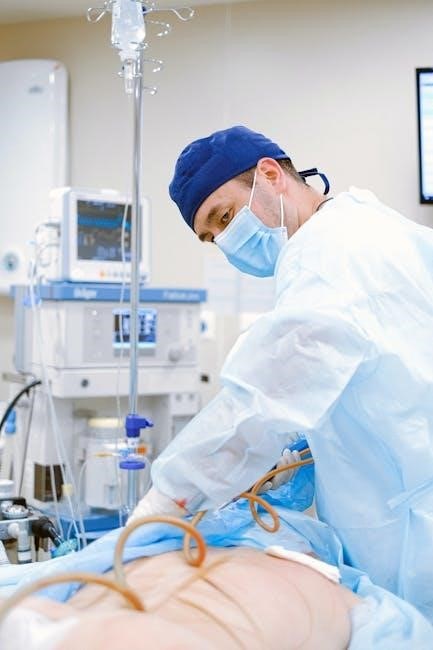Anesthesia is a cornerstone of modern surgery, ensuring pain management and patient comfort․ It enables surgeons to perform complex procedures while anesthesiologists monitor safety and effectiveness․
Overview of Anesthesia and Its Role in Surgery
Anesthesia is a medical technique that prevents pain and discomfort during surgical procedures․ It ensures patients remain comfortable while allowing surgeons to perform complex operations․ There are four main types: general, regional, local, and monitored anesthesia care (MAC)․ General anesthesia induces unconsciousness, while regional and local numbing affect specific areas․ MAC provides sedation for relaxation․ Anesthesiologists tailor these methods to individual needs, ensuring safety and efficacy․ Their role extends beyond pain management, as they monitor vital signs and adapt anesthesia levels throughout surgery․ This expertise is crucial for optimizing outcomes and minimizing risks in modern surgical care․
Importance of Anesthesia in Modern Surgical Practices
Anesthesia is vital in modern surgery, enabling pain-free procedures and improving patient outcomes․ It allows surgeons to perform complex operations without patient discomfort, enhancing precision and reducing stress․ Modern anesthesia practices focus on patient safety, minimizing risks, and optimizing recovery․ Anesthesiologists play a critical role in pre-operative planning, intraoperative care, and post-operative pain management․ Their expertise ensures tailored approaches for diverse surgical needs, from minimally invasive procedures to major surgeries․ By combining advanced techniques and personalized care, anesthesia has revolutionized surgical practices, making them safer and more effective for patients worldwide․ This evolution underscores its indispensable role in contemporary medicine․

Types of Anesthesia Used in Surgery
Surgery employs four primary types of anesthesia: general, regional, monitored anesthesia care (MAC), and local․ Each serves distinct purposes, tailored to procedure complexity and patient needs․
General Anesthesia
General anesthesia induces a controlled, sleep-like state, ensuring patients are unconscious and pain-free during major surgeries․ Administered via IV medications and inhaled gases, it suppresses pain perception and reflexes․ This type is essential for complex procedures requiring complete immobilization․ Anesthesiologists closely monitor vital signs and adjust dosages to maintain safety․ Recovery may take time, with patients cared for in the PACU until fully awake․ General anesthesia is tailored to individual needs, ensuring optimal surgical conditions and patient comfort throughout the procedure․
Regional Anesthesia
Regional anesthesia numbs a specific area of the body, allowing patients to remain awake or lightly sedated during procedures․ Techniques like epidural or spinal blocks are commonly used, especially in orthopedic, obstetric, or abdominal surgeries․ This method reduces postoperative pain and minimizes recovery time compared to general anesthesia․ Patients often receive sedation to relax during the procedure․ Regional anesthesia is favored for its targeted pain relief and lower risks of complications, making it ideal for surgeries where localizing anesthesia is beneficial․ It is a versatile option, enhancing both patient comfort and surgical efficiency․
Monitored Anesthesia Care (MAC)
Monitored Anesthesia Care (MAC) combines local anesthesia with sedation to relax the patient during minor or moderately invasive procedures․ The anesthesiologist closely monitors vital signs and adjusts sedation levels to ensure comfort without rendering the patient unconscious․ MAC is ideal for procedures like skin biopsies, cataract surgeries, or short orthopedic interventions․ It offers the advantage of faster recovery and reduced side effects compared to general anesthesia․ Patients typically remain responsive, allowing for quick assessment post-procedure․ MAC is a safe and efficient option, balancing pain management with minimal anesthesia risks, making it suitable for a wide range of surgical scenarios․
Local Anesthesia
Local anesthesia numbs a specific, small area of the body, allowing patients to remain awake during minor procedures like skin biopsies or cataract surgery․ It is administered directly to the surgical site, blocking pain signals without affecting consciousness․ This method is ideal for minimally invasive procedures, ensuring quick recovery and minimal side effects․ Patients can respond to instructions, making it a practical choice for short interventions․ Local anesthesia is safe and effective, providing targeted pain relief while maintaining the patient’s awareness and reducing overall anesthesia risks․ It is a cornerstone in modern surgical practices for its simplicity and patient-friendly outcomes․
The Anesthesia Process: From Preparation to Recovery
The anesthesia process involves pre-operative preparation, induction, maintenance, and recovery․ Continuous monitoring ensures patient safety and optimal outcomes throughout the surgical procedure․
Pre-Anesthesia Evaluation and Patient Assessment
A thorough pre-anesthesia evaluation is critical to ensure patient safety and optimal outcomes․ This process involves reviewing the patient’s medical history, assessing vital signs, and evaluating chronic conditions․ The anesthesiologist conducts a physical examination and reviews laboratory tests to identify potential risks․ Patient-specific factors, such as age, weight, and existing health conditions, are considered to tailor the anesthesia plan․ Effective communication between the anesthesiologist and patient helps address concerns and ensures informed consent․ This comprehensive assessment enables the anesthesiologist to select the most appropriate anesthesia technique for the procedure, minimizing risks and ensuring a smooth surgical experience․
Induction and Maintenance of Anesthesia
Induction of anesthesia begins with administering medications to achieve unconsciousness and pain relief․ This is typically done using IV sedatives or inhaled anesthetics․ Once induced, anesthesia is maintained to ensure the patient remains comfortable throughout the procedure․ Maintenance may involve a combination of IV medications and inhaled anesthetic gases․ The anesthesiologist continuously monitors vital signs, adjusting doses as needed to balance depth of anesthesia and patient safety․ Advanced technologies, such as end-tidal gas monitoring, help precise control of anesthetic levels․ Effective communication between the surgical team and anesthesiologist ensures seamless adjustment of anesthesia during critical moments of the procedure․
Emergence and Recovery from Anesthesia
Emergence from anesthesia marks the transition from an unconscious to an awake state․ This phase begins as anesthetic drugs are gradually reduced, allowing the patient to regain consciousness․ The recovery room (PACU) is where close monitoring of vital signs, pain, and any side effects occurs․ Patients may experience grogginess, nausea, or discomfort, which are managed with medications․ The goal is to ensure a smooth recovery, addressing any immediate post-operative needs․ Effective communication between the anesthesiologist and nursing staff is critical during this period to provide personalized care and prevent complications․ Recovery times vary depending on the type of anesthesia and individual patient responses․
Special Considerations in Anesthesia Administration
Anesthesia administration requires tailored approaches for patients with chronic conditions, ensuring safe and effective pain management during surgery․ Anesthesiologists adapt techniques based on individual needs and medical history․
Anesthesia for Specific Surgical Specialties

Anesthesia techniques vary significantly across surgical specialties, requiring specialized approaches to ensure optimal outcomes․ For example, cardiovascular surgeries often demand precise blood pressure control and advanced monitoring․ In neurosurgery, anesthesiologists must carefully manage intracranial pressure while maintaining optimal cerebral perfusion․ Orthopedic procedures may utilize regional anesthesia, such as epidural or spinal blocks, to minimize post-operative pain․ Obstetric surgeries frequently employ neuraxial anesthesia for cesarean sections, ensuring maternal and fetal safety․ Similarly, urological procedures may benefit from local or regional anesthesia to enhance recovery․ Each specialty requires tailored anesthetic strategies to address unique surgical and patient needs, ensuring both safety and efficacy․
Patient-Specific Factors Influencing Anesthesia Choices
Patient-specific factors significantly influence anesthesia selection, ensuring personalized care․ Age, comorbidities, and overall health status are critical considerations․ For example, patients with heart disease or diabetes may require tailored anesthetic plans․ Body weight and BMI also play a role, as they affect drug dosing․ Current medications, allergies, and substance use are evaluated to avoid complications․ Smoking and alcohol use can impact anesthesia recovery․ Additionally, genetic factors, such as pseudocholinesterase deficiency, may alter anesthetic metabolism․ Patient anxiety levels and previous reactions to anesthesia are also assessed to optimize safety and comfort during surgery․

Post-Operative Care and Pain Management
Effective post-operative care ensures patient recovery and pain management, minimizing discomfort and complications․ Monitoring in the PACU and personalized strategies optimize healing and patient well-being․
Recovery Room (PACU) Monitoring and Protocols
Post-anesthesia care units (PACUs) are critical for patient recovery, ensuring safe transition from anesthesia effects․ Monitoring protocols include tracking vital signs, oxygen levels, and pain management․ Anesthesiologists and nurses assess patients for complications like respiratory distress or bleeding․ Pain is managed with medications or regional anesthesia techniques․ Patients are observed until stable, with individualized care plans tailored to their surgical and medical history․ The PACU team ensures patients regain consciousness comfortably and address any immediate post-operative concerns before transfer to further recovery or hospital wards․
Pain Management Strategies Post-Surgery
Effective post-surgical pain management is essential for patient comfort and recovery․ Strategies include multimodal analgesia, combining medications like opioids, NSAIDs, and local anesthetics․ Regional anesthesia techniques, such as epidural or nerve blocks, provide targeted pain relief․ Patient-controlled analgesia (PCA) allows individuals to self-administer pain medication; Non-pharmacological methods, like ice therapy or physical therapy, may also be employed․ Personalized plans consider the patient’s medical history and surgery type to minimize discomfort and reduce opioid dependence, promoting faster recovery and improved outcomes․

Future Trends and Advancements in Anesthesia
Future trends in anesthesia include portable systems, AI-driven monitoring, and pharmacogenomics, enhancing safety, efficiency, and personalized care in surgical procedures․
Emerging Technologies in Anesthesia Delivery
Emerging technologies in anesthesia delivery include portable systems, AI-driven monitoring, and advanced pharmacogenomics․ These innovations enhance precision, safety, and patient-specific care․ Portable systems enable use in diverse settings, improving accessibility․ AI monitors vital signs, predicting risks and optimizing dosing․ Pharmacogenomics tailors anesthesia to genetic profiles, reducing adverse reactions․ Such advancements promise efficient, personalized, and safer anesthesia administration in surgical procedures․
Evolution of Anesthesia Practices and Patient Safety
Anesthesia practices have evolved significantly, prioritizing patient safety and improved outcomes․ Advances in monitoring technologies, pharmacology, and standardized protocols have reduced risks and enhanced efficiency․ Modern anesthesia integrates evidence-based guidelines, ensuring tailored care for diverse patient needs․ The development of safer anesthetic agents and precise delivery systems has minimized complications․ Continuous monitoring of vital signs and depth of anesthesia further safeguards patients․ These advancements reflect a commitment to optimizing surgical experiences, making anesthesia safer and more effective for procedures worldwide․
